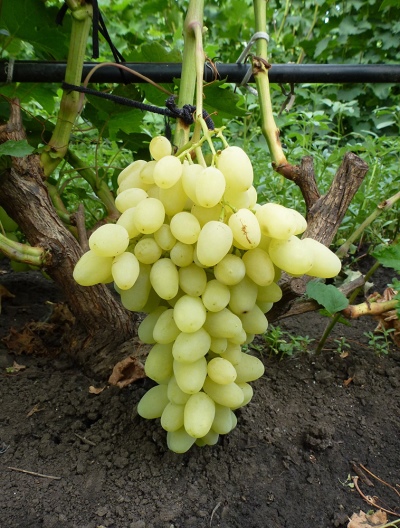
- Authors: Krainov Viktor Nikolaevich
- Appointment: dining room
- Berry color: yellow
- Taste: harmonious
- Ripening period: early
- Ripening period, days: 110
- Frost resistance, ° C: -21
- Name synonyms: Arcadia early
- Bunch weight, g: 700-1500
- Berry shape: oval
Today, most gardeners successfully grow grapes on their plots. The Zarnitsa variety pleases not only with its yield, but also with its unpretentiousness.
Breeding history
The plant was bred by an amateur breeder V.N.Krainov. They were able to evaluate the variety for the first time in 1995. It so happened that for a long time he did not know which plant would take root well in the existing lowland area. At the same time, it was required that the berries did not rot or crack. Not finding the desired species, the breeder decided to cross the Talisman and Kishmish.
The first parent of Zarnitsa has a wonderful taste, but it is capricious during growing. But the second grade - Talisman - perfectly adapts to weather conditions and terrain. It does not rot due to excess moisture, which is very important.
Geography of distribution
Today Zarnitsa is grown in many regions of our country.
Description
The described variety belongs to the dining room. This is a vigorous plant.
The foliage is large, the shade is bright green. It is worth knowing that the variety has a lot of branching roots, this is one of the reasons why few stepsons are formed. However, it is thanks to this feature that the bunches ripen faster.
Ripening period
From the moment of formation of the kidneys to their full maturation, an average of 110 days pass. You can harvest in the middle of the last month of summer. That is why grapes are early ones.
Bunches
If we talk about the shape of the bunches, then it can be characterized as conical. The density of the berries is average. Each bunch can weigh up to 1500 grams.
When the grapes are fully ripe, the clusters take on an amber-yellow hue. Peas are not typical for Zarnitsa, which is another advantage of the variety.
Berries
The flesh of the berries is dense. Each grape is oval in shape. The size is large, the weight of the fruit is up to 10 grams.
Taste
The taste can be described as sweet, with a slight sourness.
Yield
Zarnitsa grapes are high-yielding varieties.


Growing features
Despite the fact that Zarnitsa belongs to unpretentious plants, a large harvest can be achieved only if the gardener carefully looks after the grapes.
You should not plant the vine in a draft, it may freeze slightly, despite the fact that the grapes have good frost resistance.
It is imperative to do normalization. This means that no more than three bunches are left on one vine. Excess shoots must be removed in the summer.
Landing
When planting seedlings, it is very important to pay attention to the hole. Its dimensions are 1 meter by 1 meter. Planting material is placed in the center, with a depth of at least 30 cm. Only if these conditions are met, it is possible to provide the grapes with the necessary growth force.
The rhizome is carefully laid out, sprinkled with a small amount of earth and lightly tamped. Watering is indispensable. Use extremely warm water. A bush requires 15 to 20 liters.
If the groundwater is located close to the surface, then the organization of high-quality drainage is considered a prerequisite for planting.

Pollination
Flowers are formed bisexual, therefore additional pollination is not required.
Pruning
Vigorous bushes require pruning twice a season. The first is carried out before flowers begin to form on the bushes, the second - after picking the berries.
10 eyes are left on the branch. The working tool is compulsorily disinfected. Shoots are removed inside the bush, the vine is not touched.
In the spring, all branches that are frozen or dry are removed.

Watering
It is impossible to achieve a good harvest without regular watering. They begin to moisten the soil as soon as the buds open. The amount of water is increased during the period of ovary formation.


Top dressing
In the spring, it is advisable to apply nitrogen fertilizers. They help you gain green mass. Thanks to this feeding, the shoots develop faster.
In the fall, potassium and phosphorus are introduced, the latter helping to strengthen the root system.
If you want to raise yields, zinc-based fertilizers are used in the fall.
Frost resistance and the need for shelter
Zarnitsa's frost resistance is –21 degrees Celsius, but it is worth covering the grapes. Spruce branches are perfect.

Diseases and pests
To protect the grapes from diseases and pests, preventive treatment is carried out. This is done twice a year.
Slaked lime and copper sulfate are perfect. 10 liters of water will require 500 grams of lime and 300 grams of copper sulfate.
The bushes are sprayed by hand before the flowers appear.

If a grape is exposed to any disease or insect, this always affects its appearance.
Storage
The berries are stored wonderfully, they are well transported, keeping their presentation.











































































